The federally funded Monitoring the Future survey and a separate recent investigation point to the following general trends: adults have been slowly becoming more interested in psychedelics, while adolescents are generally becoming less interested in hallucinogens like psilocybin. This is proof that increasing access to psychedelics will not pose a great threat to the health of our youth, as many naysayers like to point out, and is great news for the legal psychedelic industry.
The Results Are In
A new federal poll revealed that there has been a sharp increase in young adults’ psychedelic use, whereas the use of hallucinogenic substances by teenagers has decreased, according to other recent research and surveys. Therefore the tendency appears to be restricted to adults, which could be attributed to increasing research, support, and attention on the therapeutic benefits of psychedelic substances.
More jurisdictions have taken steps to decriminalize psychedelic plants and fungi or to grant therapeutic access to the substances in light of evidence that they can effectively treat the symptoms of mental health conditions like severe depression and post-traumatic stress disorder, which is greatly increasing the amount of attention the substances are receiving – both in the scientific community and from the public.
Naturally, this increase in attention on the substances has brought up the same old, tired arguments that many people love to shout whenever cannabis or psychedelics are the topic of conversation. “Bad!” “Evil!” “But the children!” The recent findings on decreasing child use make it abundantly clear that these worries are unfounded.

About The Findings
According to the Columbia University researchers’ peer-reviewed study, adult usage of hallucinogens has increased recently, especially among individuals who are 26 and older. In 2019, the most recent year for which data is available, 5.5 million individuals reported using psychedelics in the previous year.
This is not the case, however, for teenagers. According to the study, “our findings of a decline in hallucinogen use among adolescents (aged 12-17 years) between 2002-14 and 2015-19 are important and correspond with findings from the Monitoring the Future study, which show a decline in hallucinogen and other illicit drug use among adolescents.” These results imply that policies to restrict access and public health preventative initiatives are successful in lowering teen hallucinogen usage.
The National Institute on Drug Abuse provided funding for the study, which was co-authored by Ofir Livne of Columbia University. He said that because of the study’s findings, which merit a comprehensive examination of time trends and motives for hallucinogen frequency and quantity use, there has been more media attention to the science of using psychedelics as a therapeutic tool.
Deborah Hasin, the study’s lead author stated that researchers, clinicians, and policymakers should increase their attention to the rising rates of unsupervised hallucinogen use among the general public in light of popular media reports of a forthcoming ‘psychedelic revolution’ with commercialization and marketing that will help further reduce the public perception of any risk.
According to Hasin, the results “emphasize such use as a significant public health concern and imply that the rising likelihood of possibly unsupervised hallucinogen use demands preventive interventions.”
Similar Studies
Further crucial context is provided by a separate, federally financed MTF survey, the results of which were made public before the end of last year and showed that teen drug use in general – and marijuana use in particular – decreased significantly in 2021.
The study, which has been tracking adolescent drug usage and views since 1975, also showed a sharp decline in cannabis use among eighth-graders, tenth-graders, and twelve-graders over the previous year.
Since its high in 2001, when 5.9% of 12th graders, 4.3 percent of 10th graders, and 2.4 percent of 8th graders reported using psychedelics in the previous year, MTF has observed a fairly continuous decline in teen usage of hallucinogens outside LSD.
Only 2.9% of 12th graders, 1.5% of 10th graders, and 0.8% of 8th graders reported using the drugs in the previous year as of 2021. In other words, despite the absence of regulated markets for substances like psilocybin, DMT, and ayahuasca, the rise in adult psychedelic usage hasn’t persisted among teenagers.

As more details about the potential therapeutic benefits of psychedelics are made public, and as laws governing the drugs are relaxed in cities and states across the country, more people are trying them. This is certainly getting a few backs up, as many people have believed psychedelics to be terrible in every way for a long time. However, their therapeutic benefits cannot be overlooked. Studies such as these are excellent indicators that while many continue to rage against psychedelics, support for them is not decreasing.
Enjoyed that first hit? Come chill with us every week at the Friday Sesh for a freshly packed bowl of the week’s best cannabis news!
- Ohio’s Senate Bill 56 Postponed, Leaving Details of Issue 2 Still Unresolved
- Sports Stars and Well Known Entertainers Join Forces Calling on Trump for Cannabis Reform
- Pinsky and the Brain: Bill White on His Journey to Consulting in Cannabis
- Delaware’s Recreational Cannabis Market Finally Set to Launch After Years of Challenges
- Excise Tax Increase to 19% and Its Impact on California Retailers
- Nebraska’s Governor Approves Emergency Medical Cannabis Regulations













